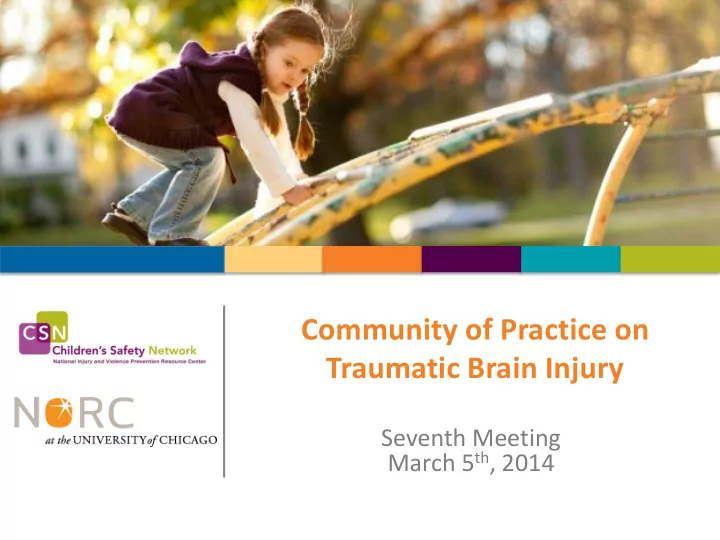

Community of Practice on Traumatic Brain Injury Seventh Meeting March 5 th , 2014
Today’s Agenda • Presentation: Community-based Concussion Management • Team Update : Nebraska & Return to Learn 2 www.ChildrensSafetyNetwork.org
Meeting Orientation Slide If you are having any technical problems joining the webinar please contact the Adobe Connect hotline at 1-800-416-7640 or email csninfo@edc.org Type any additional questions or comments into the Chat box on the left. 3 www.ChildrensSafetyNetwork.org
Presenter Dr. Karen McAvoy Director Center for Concussion at the Rocky Mountain Youth Sports Medicine Institute 4 www.ChildrensSafetyNetwork.org
Concussion Management It Takes a Village Karen McAvoy, PsyD Center for Concussion
http://www.visualizing.org/visualizations/concussion-laws-state
Second Impact Syndrome (SIS)
center4concussion.com
10
http://www.nasponline.org/publications/cq/40/6/return-to-learning.aspx
Recovery From Concussion 100 90 80 % Recovered 70 60 50 Series1 40 30 20 10 0 1 2 3 4 5 Collins et al, 2006 Weeks Post Concussion Neurosurgery 12
Seamless System of Communication and Collaboration 14
REMOVE/REDUCE REMOVE from all physical activities! • No organized sports • No recreational play • No PE, dance class • No physical play at recess REDUCE home stimulation! REDUCE school demands! • No texting •Mental Fatigue • No TV •Slowed Processing Speed • No computer screens •Difficulty converting memory • No video games into New Learning
FAMILY TEAM SCHOOL ACADEMIC TEAM Legislation REDUCE Keep home if severely Limit texting. symptomatic. Limit TV, video Return to school when Fam/ C games, computer Stud. symptoms are still O time. present but tolerable. N Limit homework. Eliminate work, C Limit driving. Coach REDUCE work, adjust U ATC Keep home from work. Nurse S dances, games, the S mall. Decrease I stimulation. PACE MENTAL O REST! DEMANDS N Medical T I M E (usually between 7 to 21 days)
Symptom Wheel P HYSICAL C OGNITIVE -headache/nausea Trouble with: -dizziness/balance -concentration problems -memory issues -blurred vision/ -mentally foggy photophobia -slowed processing -noise sensitivity -neck pain E MOTIONAL Sleep/Energy Feeling more: -mentally fatigued -emotional -drowsy -nervous -sleeping too much/too -sad little -angry -can’t initiate/ -irritable maintain sleep National Association of School Psychologists (NASP) Communiqué by Dr. Karen McAvoy CDE Concussion Management Guidelines (page 13)
Mental Fatigue Shortened day if needed – but only for a limited time Student should be at school to maximize instruction Instruction (input) can’t be replicated. Work (output) can be adjusted! “strategic rest breaks” 5 to 10 minutes of “eyes closed/head down” per period Cutting back homework and in-class work Reducing # of problems “Auditing” lecture material Oral vs written output Sunglasses or earphones to reduce stimuli Emotional reactions are often signs of mental fatigue
Slowed Processing Speed Cut back on the amount of work. Go for quality not quantity No tests in the beginning. Eventually, extra time on projects and tests Tests can tax the brain – effect recovery Tests will not be accurate – not best measure right now Use of technology for organization and ease (buddy notes, tape recorder, smart pens) Adjust due dates – but do not carry over too much work, it is not possible, it is not reasonable!
Difficulty Learning New Material Be thoughtful about your teaching. What is most important for the student to know at this time? Focus on comprehension, not memorization Remove, do not postpone work: REMOVE – consider 25% NEGOTIABLE – alternative project OR delay – but consider delaying no more than 25% REQUIRED – consider no more than 25% Piling up work causes the biggest source of stress and it hampers recovery!
Recovery From Concussion 100 90 80 % Recovered 70 60 50 Series1 40 30 20 10 0 1 2 3 4 5 Weeks Post Concussion 24
Front Load your interventions … and then taper back
Coach ATC C O N C U S 100% back 100% back Health S to pre- to pre- I Care concussion concussion O Provider level at level at N home now! school now! T I M E (usually between 7 to 21 days)
1. Garbage in, garbage out. 2. Neurocognitive testing is simply a tool to measure recovery, it is NOT the treatment. 3. Get corroborating data – Teacher Feedback Form, it prevents “Sandbagging”.
Emergency Department REAP Schools Reached with REAP by Year To Date: 1693 families 300 Get REAP in ED 250 • Follow-up call to Number of Schools Educated parent 98 167 200 • Encourage New Schools Educated follow-up with with REAP 150 healthcare provider of their Schools Previous 193 100 Educated with REAP choice 163 126 • Follow-up call to 50 school • REAP sent to 0 school is needed 2010-2011 2011-2012 2012-2013 Year
Karen McAvoy, PsyD Center for Concussion QUESTIONS? 720-979-0840 Karen.McAvoy@HealthONEcares.com
Team Update Nebraska : Introduction of Return to Learn Legislation “To require schools to establish a return to learn protocol for students who have sustained a concussion. The return to learn protocol shall recognize that students who have sustained a concussion and returned to school may need informal or formal accommodations, modifications of curriculum, and monitoring by medical or academic staff until the student is fully recovered" 36 www.ChildrensSafetyNetwork.org
Thank you for your participation Please take a moment to complete our short evaluation: https://www.surveymonkey.com/s/CGGVW6T Questions or Comments? Contact: Rhunt@edc.org 617-618-2178 37 www.ChildrensSafetyNetwork.org
Recommend
More recommend